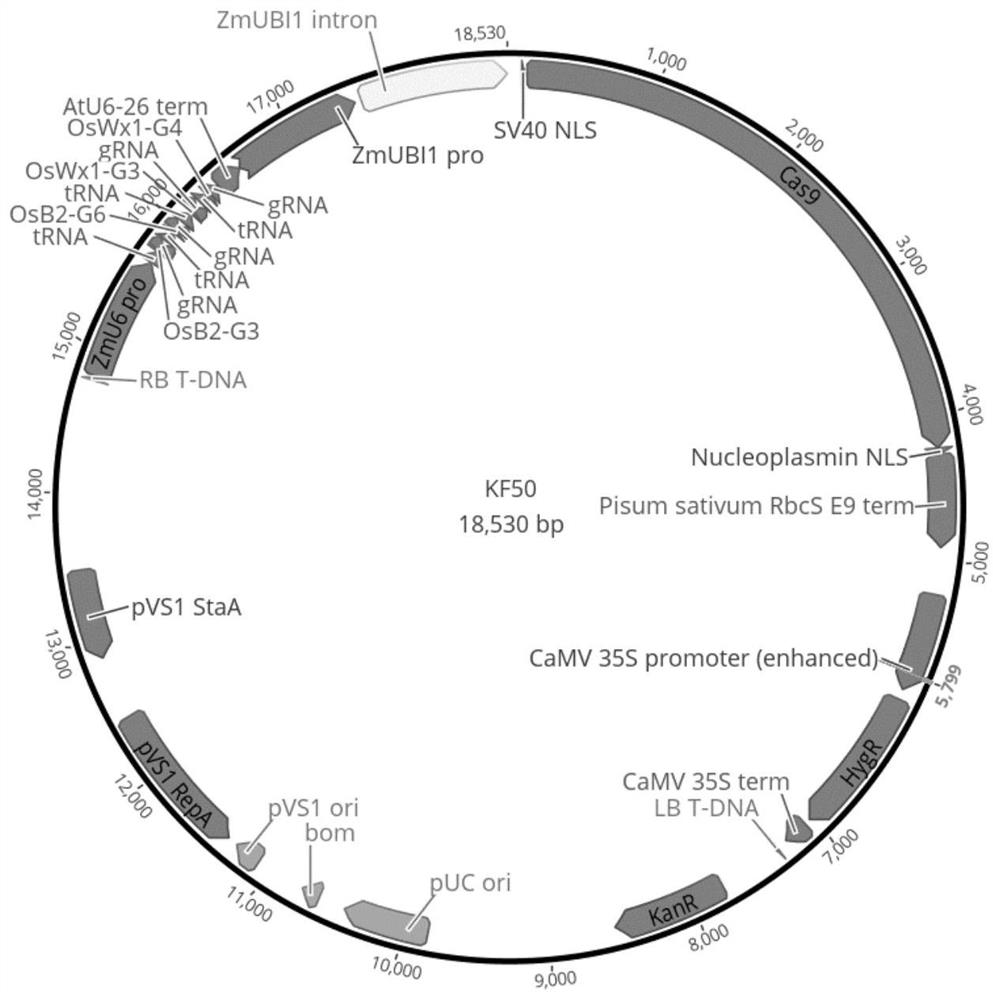Gene editing and application of rice quality trait gene
A gene editing, rice technology, applied in the field of crops to achieve the effect of efficient gene editing
- Summary
- Abstract
- Description
- Claims
- Application Information
AI Technical Summary
Problems solved by technology
Method used
Image
Examples
Embodiment 1
[0086] The outstanding advantage of gene editing breeding is that the target gene can be pre-selected for editing. The technical principle is to use specific endonucleases to cut the target gene at the designed site, and through the cell's own DNA damage repair system, the broken DNA will be non-homologous end joining (NHEJ) or homology-dependent recombination (HDR) There are two main ways to fix it.
[0087] This embodiment includes: 1. Construction of genetic transformation and editing vectors, constructing molecular tools such as specific endonucleases into the transformation vectors; 2. Genetic transformation of recipient plants, placing the above-mentioned molecular tools in cells to play a role; 3. 1. Molecular biological analysis of transformed and regenerated plants, detecting the status of the target gene editing site, and confirming whether the gene editing is successful; 4. Molecular biological analysis of the offspring of the gene editing plants, confirming the edi...
Embodiment 2
[0123] 1. Construction of gene editing transformation vector:
[0124] Using the same KF50 as described in the construction of the gene editing transformation vector in Example 1 as the gene editing transformation vector, the Kenfeng Seed Industry's self-owned rice variety Longken 290 was improved by gene editing to increase the aroma and waxy quality traits.
[0125] 2. Genetic transformation of japonica rice:
[0126] Using the genetic transformation method for indica rice described in Example 1, the gene editing transformation vector KF50 was used to transform the self-owned rice variety Longken 290 of Kenfeng Seed Industry. The transformed japonica rice variety is easy to produce callus, has strong differentiation and regeneration ability, and high transformation efficiency , suitable for Agrobacterium transformation. Resistant calli were screened for about 3-4 weeks after infection with the gene editing vector, and were directly transferred to the differentiation medium ...
Embodiment 3
[0140] 1. Construction of gene editing transformation vector:
[0141] Using the same KF50 as described in the construction of the gene editing transformation vector in Example 1 as the gene editing transformation vector, Kenfeng Seed Industry's self-owned rice variety Kendao 32 was improved by gene editing to increase the aroma and waxy quality traits.
[0142] 2. Genetic transformation of japonica rice:
[0143] Using the indica rice genetic transformation method described in Example 1, the Kenfeng Seed Industry’s own rice variety Kendao 32 was transformed with the gene editing transformation vector KF50. The transformed japonica rice variety is easy to produce callus, has strong differentiation and regeneration ability, and high transformation efficiency , suitable for Agrobacterium transformation. Resistant calli were screened for about 3-4 weeks after infection with the gene editing vector, and were directly transferred to the differentiation medium for 3-4 weeks to diff...
PUM
 Login to View More
Login to View More Abstract
Description
Claims
Application Information
 Login to View More
Login to View More - R&D
- Intellectual Property
- Life Sciences
- Materials
- Tech Scout
- Unparalleled Data Quality
- Higher Quality Content
- 60% Fewer Hallucinations
Browse by: Latest US Patents, China's latest patents, Technical Efficacy Thesaurus, Application Domain, Technology Topic, Popular Technical Reports.
© 2025 PatSnap. All rights reserved.Legal|Privacy policy|Modern Slavery Act Transparency Statement|Sitemap|About US| Contact US: help@patsnap.com



